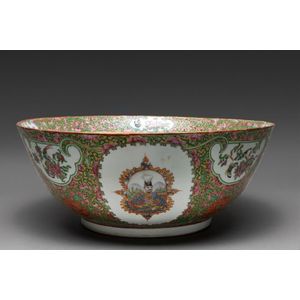Qajar Portrait Bowl from Baker Estate
A Cantonese export famille rose porcelain bowl made for the Qajar market, Qing Dynasty, circa 1865 of hemispherical form on a short foot, in the rose medallion pattern, with three cartouches with roundels bearing portraits of Nasr al-Din Shah and his two Sons Masoud Mirza (later Zill al-Sultan) and Muzaff are al-Din, one cartouche with a roundel bearing inscription. The inscription reads: 'Nasr al-Din Qajar, Al-Sultan Ibn Sultan', 37.5 cm diameter. Provenance: Estate of George Baker (1822-1905), UK., hence by descent. George Baker in 1848 designed and supervised the creation of the garden at the British Embassy at Constantinople and, after completing the work, in Constantinople went into the trading business, including the export of Turkish carpets. His two Sons George Percival Baker (1856-1951) and James Baker founded G. P. & J. Baker-the famous textiles store in 1884, which is still operating today in London. G. P. Baker was An important collector of early Oriental fabrics and a leading export on calico panting and printing in the East Indies. Victoria and Albert Museum, London held the exhibition: from East to West: textiles from G. P. & J. Baker, 9 May-14 October 1984. More detail of the family history and their textiles collection, see this exhibition catalogue by Bridget Heal.
You must be a subscriber, and be logged in to view price and dealer details.
Subscribe Now to view actual auction price for this item
When you subscribe, you have the option of setting the currency in which to display prices to $Au, $US, $NZ or Stg.
This item has been sold, and the description, image and price are for reference purposes only.
- Qing Dynasty - The Qing Dynasty was the last imperial dynasty of China, ruling from 1644 to 1912. It was established by the Manchu people, who originated from the northeastern region of China. The Qing Dynasty was preceded by the Ming Dynasty and followed by the Republic of China.
- Cartouche - An ornamental panel in the form of of a shield, oval or rectangular scroll with curling edges. It may be carved into the back of a chair or the top of a sideboard, or present on a piece of silver or jewellery, and contain the initials of the original owner, heraldic symbols, or some other inscription, such as the details of a presentation.
In ceramics the term defines the central area of a vase or similar with a decorative border in one of the shapes above, into which a decorative scene or figures have been painted. - Roundel - A roundel is a circular disk, medallion or border on a plate or dish, on an object of furniture. A plate or dish will often have a central circular bordered decoration, termed a roundel. In furniture the word is often used instead of the word 'patera' to describe a turned circular decoration. In recent times use of the word has expanded to encompass any circular area on an object.
- Ming Dynasty - The Ming Dynasty was a ruling dynasty of China from 1368 to 1644. It succeeded the Yuan Dynasty and preceded the Qing Dynasty. The Ming Dynasty was established by Zhu Yuanzhang, a former Buddhist monk who became a rebel leader and eventually overthrew the Mongol Yuan Dynasty. During the Ming Dynasty, China experienced a period of relative stability and prosperity. The government was centralized and bureaucratic, with the emperor at the top of the hierarchy. The Ming Dynasty is known for its cultural achievements, including the development of porcelain, the invention of movable type printing, and the construction of the Great Wall of China.
- Circa - A Latin term meaning 'about', often used in the antique trade to give an approximate date for the piece, usually considered to be five years on either side of the circa year. Thus, circa 1900 means the piece was made about 1900, probably between 1895 and 1905. The expression is sometimes abbreviated to c.1900.
- Important - Important is a word used in the antique trade to indicate an object should be ranked above other similar objects, and is therefore more valuable.
The object could be considered important because it is by a famous designer or maker, has been shown at a major exhibition, is of exquisite workmanship, is rare or is a "one-off", was made for an important patron, and so on.
Even further up the pecking order are objects that are described in catalogue descriptions as highly important or extraordinarily important.
This item has been included into following indexes:
